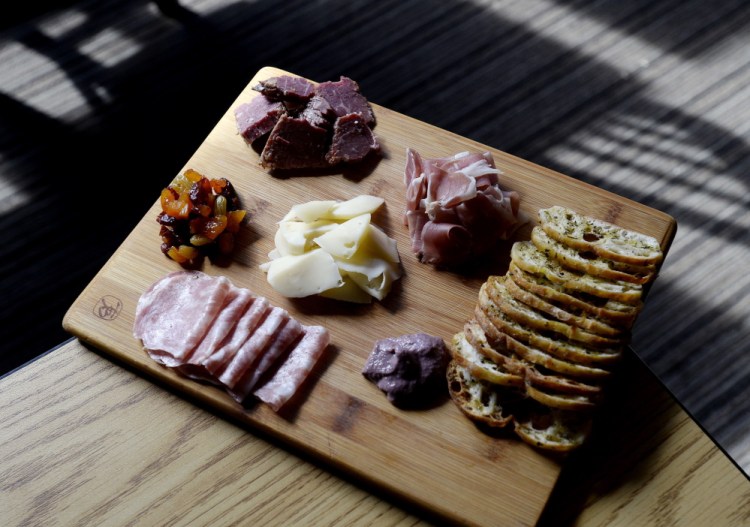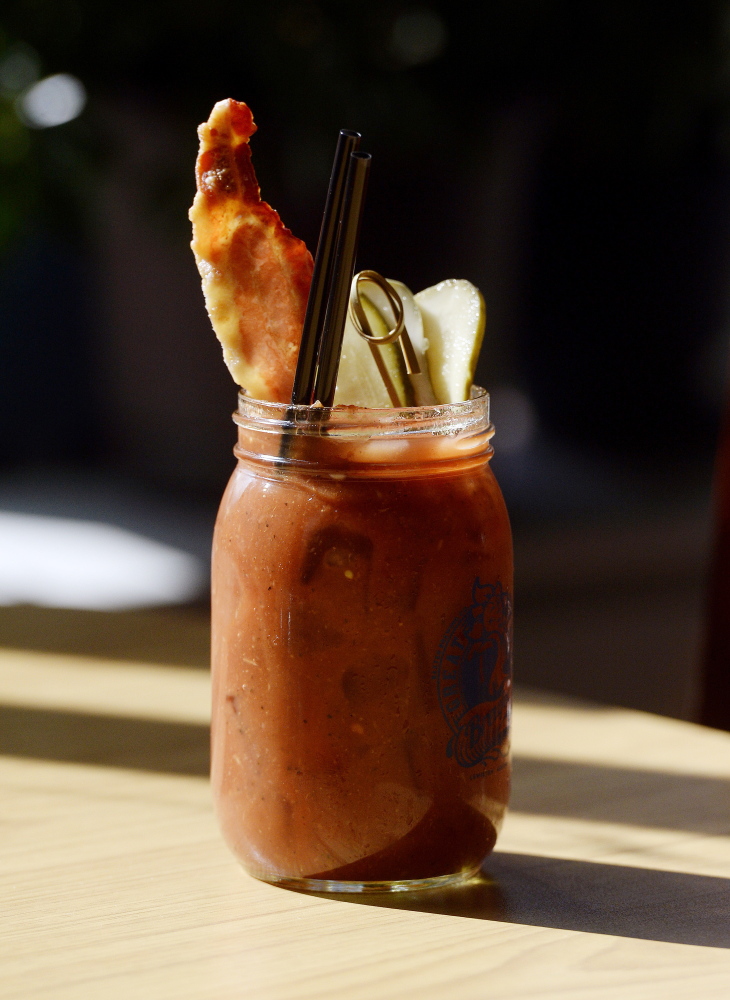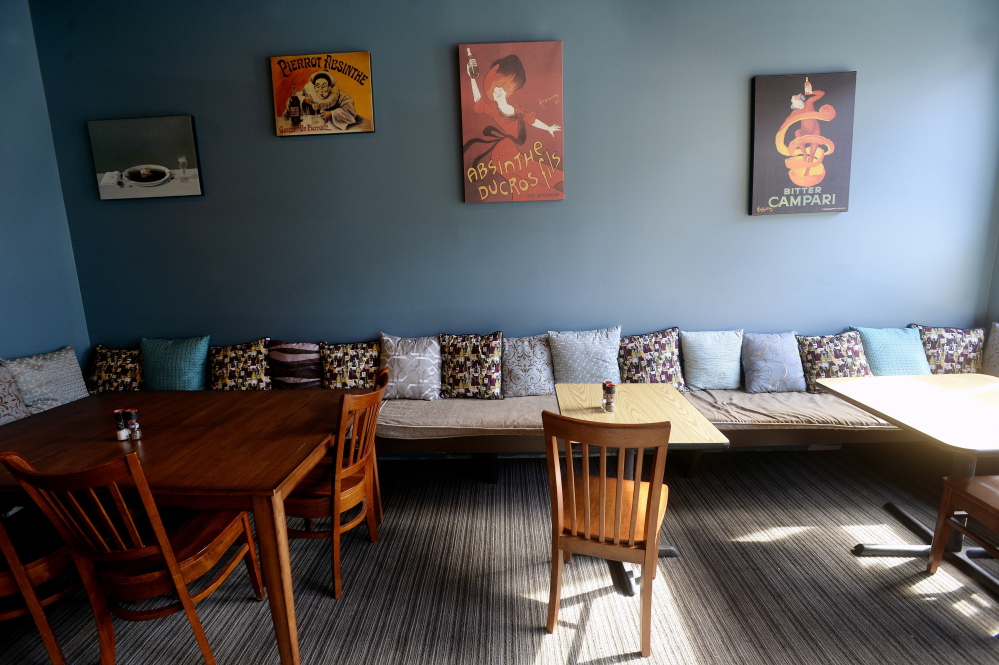Driving into Lewiston on a foggy night can be haunting. The skyline is punctuated by sprawling witnesses to the city’s industrial past, most of them shuttered and dark after dusk. But the lights are blazing at Marché Kitchen and Wine Bar on Lisbon Street.
Marché reminds me of a college town coffee house that’s grown up – somewhat. The bohemian influence is still strong: The wooden tables are mismatched and often scratched. Strings of Christmas lights frame the panes of the front windows and a few potted schefflera plants reach for the light. Posters touting once-popular French liqueurs dot walls in no particular order, and a single vase of dried leaves and plastic flowers in the corner near the open kitchen looks forlorn and forgotten.
I felt a bit forlorn and forgotten after being seated: We’d made reservations for dinner, and there were a few tables in the busier front-of-house with tablecloths and a view of the street, but we were seated in back where the primary distraction was a large flat-screen television playing an obscure Katharine Hepburn-Bob Hope movie from the 1950s. Only one waitress was tending tables, and it took quite a while for her to deliver menus as well as water glasses. (The restaurant must have had a surfeit of glassware when it opened. Chandeliers here are made of wine glasses hung upside down to catch the light from a central fixture.)
Marché bills itself as a “Kitchen and Wine Bar,” and with good reason: The bar manager, Tom Ardia, is skilled and energetic. He was mixing and delivering drinks, recommending wine pairings and generally enhancing the quality of the experience for guests throughout the restaurant. His winning personality was a bright spot in an otherwise disappointing evening.
Things started well enough. A charcuterie plate for two ($13) arrived on a wooden board piled with tasty house-corned beef, thin slices of prosciutto, salty soppresatta, shavings of Swiss and a row of extra-crisp crostini lined up like a fan of playing cards. (The menu features American classics, French-, Spanish-, and Mediterranean-inspired dishes.) The meats were particularly good – especially the dry salami – and a dollop of Cabernet-Blackberry-Dijon mustard proved a delicious complement, but this was lamentably the culinary high point of the evening.
I wanted to try a Burrata and Prosciutto Plate ($10) because the idea of cloud-like Burrata, the super rich, super soft Italian cheese made from mozzarella and cream, sounded excellent with Mission figs and olive oil, but the kitchen had sold out – at 6 p.m. The apologetic waitress suggested a salad instead, and recommended one featuring roasted beets from Lakeside Family Farm in Newport ($9). Spinach leaves, check, segments of orange and grapefruit, check. But the touted beets were hard to find, and the dressing forgettable.
Our entrees were just as bland. Pulled pork tacos ($10) were supposed to spotlight house-roasted pulled pork topped with a crunchy apple slaw and wrapped in a soft flour taco. While the slaw was refreshing, that pork was uninspired and uninteresting. I wish we’d tried the beer pairing printed on the menu (every appetizer and entrée is listed with a suggested wine or beer), as a glass of Smuttynose Shoals Pale Ale might have enhanced the taco’s flavor, or at the least have helped me to forget its defects.
Chicken Marsala ($10) was another letdown. The seared chicken breast – and thin strands of angel hair pasta – were both overcooked, and swimming in an unappealing sweet wine sauce. And the plate was a symphony in brown, a study in monochromes: brown chicken, brown chunks of prosciutto, brown sauce, brown sauce-cloaked pasta.
The menu suggested pairing chicken with a Côtes du Rhône, the earthy, medium-bodied red wine from France. Perhaps pairings are the secret to enjoying Marché? Start with a shared plate of charcuterie, then choose one of the thoughtfully selected wines or beers. Like any college town coffee house, this is a casual place where you can comfortably nurse a drink, and – based on the crowd the night we visited – it’s a magnet for office workers and friends sharing a round and a few nibbles.
There was one happy surprise waiting for us at dinner and that was dessert, a house-made cheesecake ($8) that was creamy and deeply satisfying. The strawberry balsamic sauce drizzled over the top added depth and tartness.
On the way out, I noticed that Marché was open for brunch on weekends, so I went back on a Sunday to see if eggs and pancakes were the kitchen’s true calling. To my surprise, the restaurant felt much more welcoming in the light of day. There were pillows and soft cushions that I hadn’t noticed around the mismatched tables up front. A kind maitre d’ in jeans was working the door. The coffee was strong and the fruit juices freshly squeezed…even those struggling potted plants looked happier.
A Bloody Mary ($8) confirmed my earlier positive impression of the bar staff: They know how to mix a drink. The scalding blend of tomato juice, spices and a pickle (plus a shot of vodka) arrived in a jelly jar with a slice of bacon as a swizzle stick. It was tongue-numbingly good. But the dishes that followed were, once again, a letdown. Corned beef that had tasted fine on the charcuterie plate paled to insignificance in an overly salty potato and onion hash ($12), and the two fried eggs on top were seriously undercooked. Two more undercooked huevos made an appearance atop huevos rancheros ($11), which weren’t helped by flavorless tomatoes and a paltry number of black beans.
Marché reopened last August after a complete renovation, and the new proprietors, Susan and Gary Hall, also own The Vault, a wine and craft beer shop located just down the block. They may still be modifying their business plan, but three obvious possibilities stand out: Stick to the charcuterie and cheesecake. Nix the more elaborate plates. And flip the restaurant’s name: Currently, it’s Marché Kitchen and Wine Bar; Marché Wine Bar (and Kitchen) might be a better recipe for success.
James H. Schwartz has covered food, travel and architecture for The Washington Post, Downeast, Coastal Living and Southern Living magazines for more than 30 years. Long a commuter between Portland and Washington, DC, he retired from his job as vice president at the National Trust for Historic Preservation in 2013 and relocated to Maine.
Send questions/comments to the editors.





